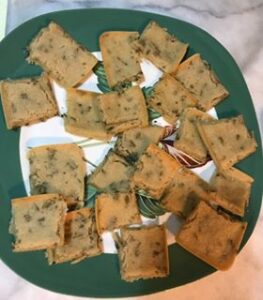Tuesday eating from your yard tip~kitchen sage (Salvia officinalis) is one of many sages and one of my top five favorite herbs. I have kept the medicinal separate from the culinary in these posts, but with sage the history is too intertwined. There was a medieval staying ~why should a man die, while sage grows in his garden. Sage was also one of the ingredients in the legendary “four thieves vinegar”, which protected the four thieves who robbed the bodies stricken by the bubonic plague/Black Death in the Middle Ages. When they were finally caught, the judge made a deal with them that they would be executed in a less horrible way if they shared how they managed not to succumb to the plague. Today the exact recipe has been lost and many variations can be googled, but most contain garlic, lavender, horehound and sage. The last couple winters I’ve followed Susun Weed’s suggestion to infuse honey with chopped sage leaves to prevent colds from taking hold.
Besides the many medicinal benefits sage is yummy~both the leaves and flowers are edible. My favorite is chopped sage leaves in quark, followed by powdered sage leaves (dried sage leaves ground in a coffee grinder) sprinkled on hot popcorn, then third quick frying the leaves in oil. Try sage leaves between the meat and veggies on your shish~kebab. Sage makes a lovely infused vinegar, alcohol or water! Sage breaks down fatty meats and helps with digestion, so it is often paired with fatty meats like sausage, pork or duck/goose. Maggie Pleskac, the high priestess of vegetarian cooking, told me about sage butter (4 parts butter, 1 part honey, and fresh sage leaves to your taste) on sweet potatoes. I’m still waiting for my brewing friends to make some sage beer, which I read English and French farmers drank to promote health. Like many during the pandemic I’ve been using my extra time to experiment with sourdough. A Facebook friend, Robert Buckley, provided the inspiration for sage sourdough crackers.
The sage flowers have a milder flavor. My friend Sherry Miller said the kids at the nature explore daycare are particularly fond of eating the sage flowers. At the end of your meal the ever versatile sage will clean your teeth ~ just run the sage leaf over your teeth. How do you eat sage?
– Jill Kuhel




